In every neighborhood, there’s always that one neighbor… You know the one.
He’s mostly harmless, but you still keep an eye on him because of that one time he got a little too drunk during the barbecue and decided to go skinny dipping in the kiddie pool. You know that he has it in him to be destructive, but he’s not malicious.
In the bee world, that’s the wax moth. Also known as the greater wax moth or honeycomb moth, wax moths are known parasites to honeybees and their hives.
Wax moths are like roaches. They feed off leftover scraps, they are disgusting to look at, and they make you look bad. They are also a symptom of neglect.
Grant Gillard wrote, “Wax moths keep us from becoming lazy. Conversely, they make us pay dearly for our procrastination. They wake us up from lethargy and reinforce our resolve how we have to be better beekeepers and more efficient managers of our resources”.
That helps to put things into perspective. Basically, wax moths are only likely to become a problem in our beehives if we let them.
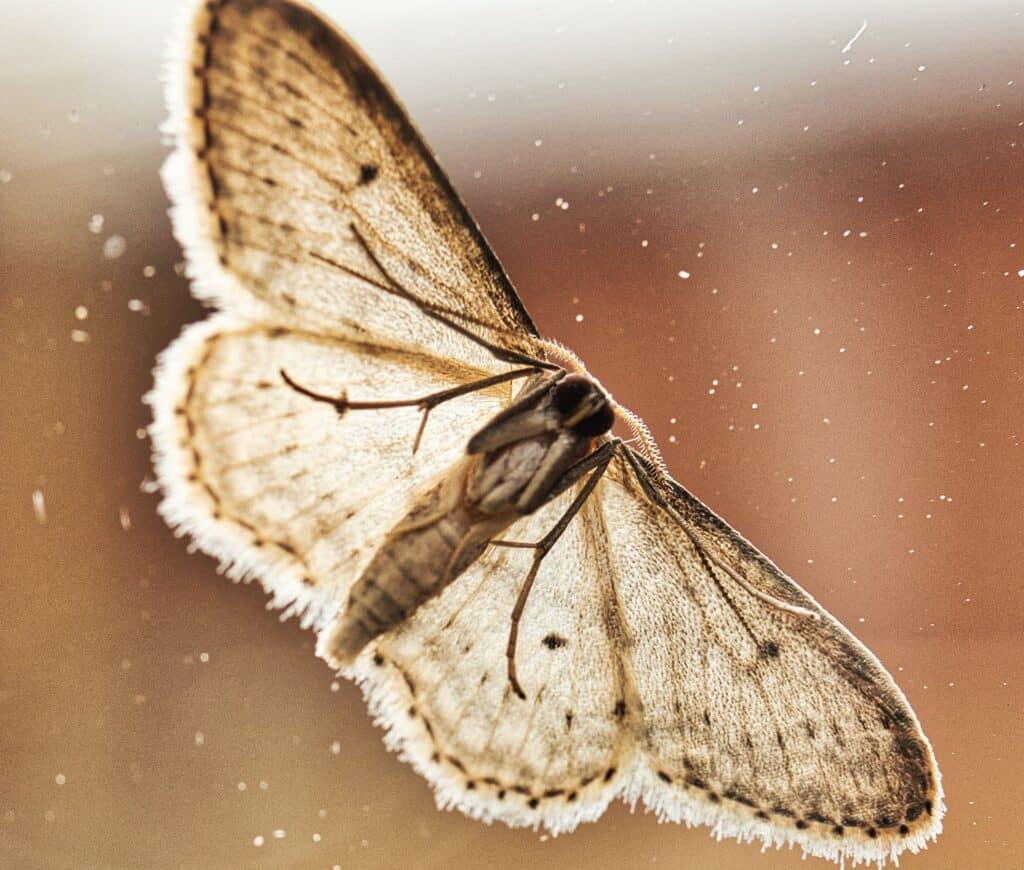
Causes of Wax Moths in a Beehive
Wax moths in a beehive can be caused in the following ways:
- A dead or dying colony
- Incorrect storage of comb
- Low comb-to-bee ratio
Let’s look at each cause in a little more detail.
A Dead Or Dying Colony
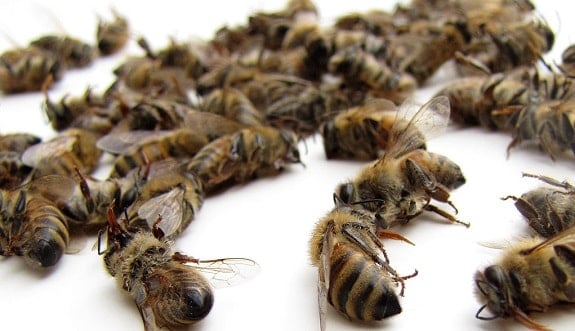
When the cleaning duties get neglected, all sorts of critters congregate in the dark corners and start living off your filth. In the hive, if there aren’t enough workers, they can’t clean out all the comb in the hive. This encourages wax moth development, and they are able to thrive.
The wax moth is most destructive in its larval stage of development, and that’s when it dominates the abandoned brood comb. The Greater Wax Moth larvae don’t really have defense systems, so they would easily be overpowered by healthy adult bees.
If the worker bees are few or sick, then they don’t have the manpower to clean the house effectively, which is how the larva manages to survive inside the hive.
Incorrect Storage Of Comb
What do you do when you’re done harvesting your honey at the end of summer?
We know that the supers don’t make it back to the hive until spring. So most of us get our honey and then stack up our supers and wait for springtime to come around again.
In addition, you also stack up formerly occupied hives with their comb still intact. The wax moth takes advantage of the conditions created by your storage technique. Stacking all the hive bodies and supers creates dark and possibly damp conditions ideal for the wax moth to thrive.
The adult female moths make their way into the hive and lay moth eggs while your supers are in storage. The eggs are so small that you wouldn’t even notice them.
Even though low temperatures slow their rate of development, they can still thrive in your stored comb.
The risk is even higher in areas that are relatively warm during the winter months.

Low Comb-To-Bee Ratio
Sometimes, the bee colonies that make it through the winter are small. Other times, one colony can swarm several times. Each time, the bee population gets smaller and smaller.
If the colony was in double deep, the remaining residents would not be appropriately staffed to maintain the mansion as it should be kept.
So, if an adult wax moth happens to lay her eggs somewhere in the unused brood chamber, her hatched larva will be in larva heaven, with all the cocoon scraps they can eat.
As they take over the brood chamber, they may cause your small colony to abscond if the domination isn’t arrested in time.
How to Get Rid of And Treat Wax Moths in a Beehive
The 5 ways to get rid of wax moths in a beehive are to:
- Cut out the affected comb
- Freeze frames
- Use heat
- Employ Carbon Dioxide treatment
- Use Fire Ants
Cut Out Affected Comb
Should you open the hive and find sections of comb covered in webbing, the best way to deal with that is to cut out the affected area. You are likely to find lots of wax moth larvae still living in all that mess.
What you cut, you must destroy. The larva is known to travel from one hive to another, so don’t just cut the affected comb out and dump it on the ground. To be safe, burn it to ensure that you kill wax moth eggs and larvae immediately.
Freeze Frames
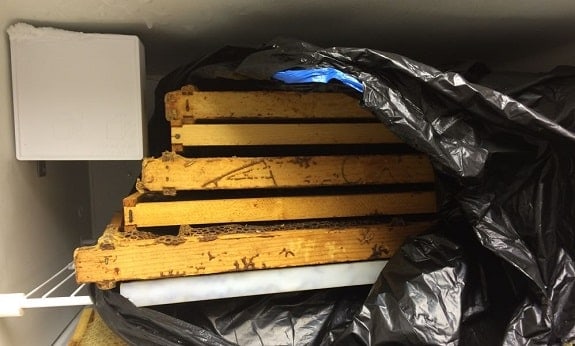
Wax moth eggs are very small and difficult to see. As a precaution, it is best to freeze the drawn-out comb before you store it.
In order to kill the eggs, they must be exposed to temperatures of about 20°F for at least four and a half hours or 5°F for two hours. It is important that your timer only begins when the temperature of the comb drops to the specified level, not when you insert all the frames into the freezer.
This also works for comb honey. To avoid having your customers open their new package of chunky honey and find some freeloading swimmers in their jars, you are encouraged to freeze the comb honey first. This has minimal effect on the quality of your honey and serves to protect you from some bad press from unhappy customers.
Heat Treatment
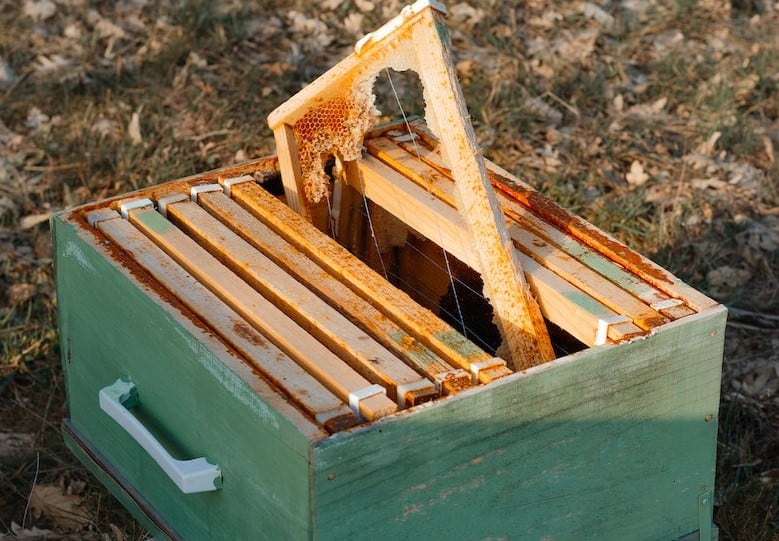
If you can’t freeze, boil. Usually, water and wood don’t mix, but you won’t be boiling the wooden frames.
You simply need to dip them in very hot water and keep them submerged for about 5 minutes. I tend to do this after I have cut out all the affected comb, and I don’t have the storage space in my freezer.
Once you remove the frames from the water, you can hang them up in a well-ventilated, lit area. This allows the wood to dry and prevents further infestation.
The moth only chooses to lay her eggs in dark corners. The boiling water also helps to remove all the wax that you were unable to scrape off. This allows you to set up a new foundation that is less attractive to wax moths.
If you prefer the foundationless approach, your bees will be able to draw brand new comb when you place the frames in the hive in the next season.
If the comb is still present, heat treatment can be applied, but it has to be controlled. The comb should be exposed to the heat of 115°F for 80 minutes or 120°F for 40 minutes.
As you know, the structural stability of combs can be compromised by heat, which is why you cannot heat them above 120 degrees. This will kill the eggs but isn’t suitable for treating the already damaged comb.
Carbon Dioxide Treatment
Commercial beekeepers can fumigate the combs with carbon dioxide. The advantage of using this compound as a chemical fumigant is that it has no adverse effects on the bees after use. Chemical fumigants can leave residues that can affect the health of your bees.
Don’t reach for the fire extinguisher just yet. You need a fumigation room for this to be done effectively, which is why this is only a viable option for large-scale beekeepers.
The fumigation chamber has to be airtight because of the saturation levels you will be dealing with. The air inside the chamber will be between 80-98% saturated with carbon dioxide, which can be very dangerous for people.
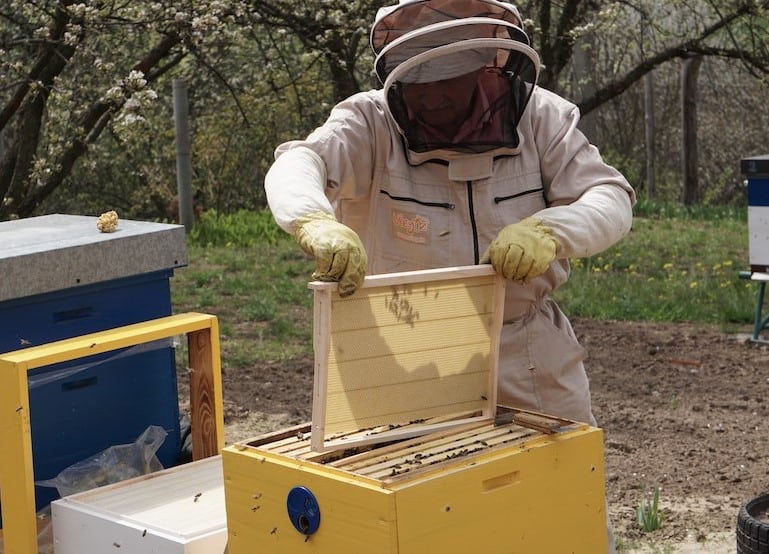
Fire Ants
What’s more natural than using one insect to get rid of another insect? This method isn’t for the faint-hearted, so it isn’t used very often. There’s also the added responsibility of acquiring and controlling a colony of fire ants.
If you choose this method of treatment, ensure that you have your bees clean out recently harvested honeycombs before you expose them to the ants. If the combs still contain honey, the fire ants may damage the comb while trying to get at the honey.
So, next time you see fire ants snooping around your stored honeycomb, treat them as friends rather than foes.
How to Prevent a Wax Moths Infestation in a Beehive
Trap The Adults
Wax moths are still present in a beehive even when you can‘t see them. They strike when security at the hive’s entrance is at its lowest.
In the evening, the guard bees aren’t as vigilant because most of the ladies are already back. The moth then makes her undetected entrance and looks for some dark crevices where she can lay her eggs.
Setting a moth trap around the apiary could help to reduce the number of adult moths making their way into the hive.
Invest In Hygienic Bees
We breed bees for honey production, temperament, and even hygienic behavior.
This means that you delegate the duty of wax moth infiltration to your bees, and their genetic predisposition makes them very good at their job.
Early detection of wax moth larvae is vital to minimizing the damage caused by the pest. With bees programmed to be thorough, they are capable of detecting and evicting unwelcome visitors as well as cleaning out debris that the wax moth larvae leave behind.
Replace Old Brood Combs With New Foundation
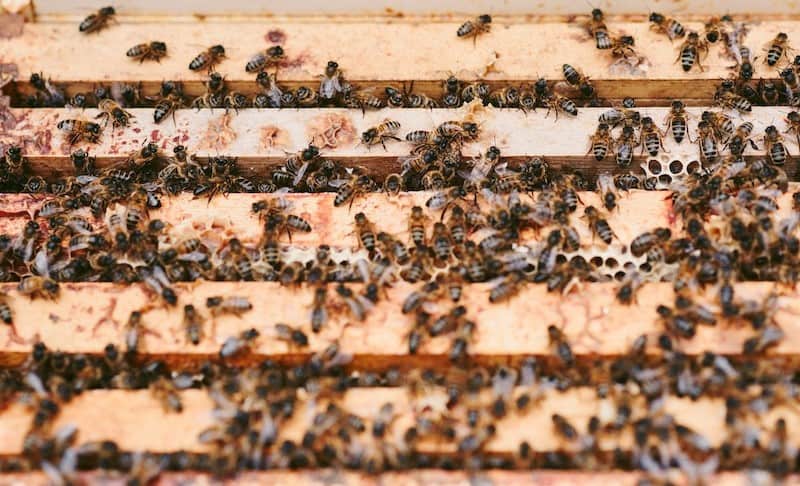
Although drawing comb does take a lot of energy from the bees, they are quite capable of drawing comb in a considerably short time if the colony is healthy.
If you have a hive that was previously occupied, why not cut out the old comb and put in a new foundation when installing a new colony?
This not only helps to avoid a wax moth infestation but helps to reduce the accumulated pesticide residue in the hive.
Lots of chemicals used to fight insects are lipophilic, meaning they are absorbed by the wax. Over time, the residue can have adverse effects on the brood, so it is a good idea to provide your bees with a clean slate to start over.
Don’t Leave Supers Of Drawn Comb On Unoccupied Hives
Wax moths are the squatters of the bee world. If the bees have left the building, they don’t travel with the furniture.
The moths regard that abandoned hive as prime real estate.
Extract Honey Within 2 Days Of Hive Removal
Even though you are not under any pressure to return the supers to the hive immediately after you have harvested your honey, it is good practice to harvest the honey as soon as you remove it from the hive.
Once you’ve harvested the honey, then you can store your frames appropriately for the winter. Leaving the supers too long provides the perfect environment for wax moths to lay eggs.
Without the presence of worker bees, these eggs will hatch and wreak havoc on your combs in storage.

4 Ways Wax Moths Affect A Beehive
Comb Destruction
The wax moth larvae tunnel through the comb, seeking out little cocoon remnant goodies to feast on. As they travel, they leave behind very sticky webbing in their wake. As they feast on the comb, the wax is so degraded that it can’t be rendered for sale or reuse.
Indirectly Causes Honey Bee Deaths
The webbing caused by the larva is very similar to a spider’s web. It is strong and sticky. As the larvae go about cleaning up the metamorphosis residue in the formerly occupied cells, they inadvertently spread their web over the capped brood.
When it’s time for new honey bee adults to emerge, they find themselves trapped under a substance they aren’t designed to break through. They can’t get out, and they starve to death.
Eventually, this can also cause you to have a weak hive.
They Burrow Into The Hardware
When the larvae are ready to pupate, they eat into the wooden hardware of the hive frames.
They then spin their wax moth cocoons, which remain in place even after they emerge. This continuous burrowing can compromise the hive body over time.
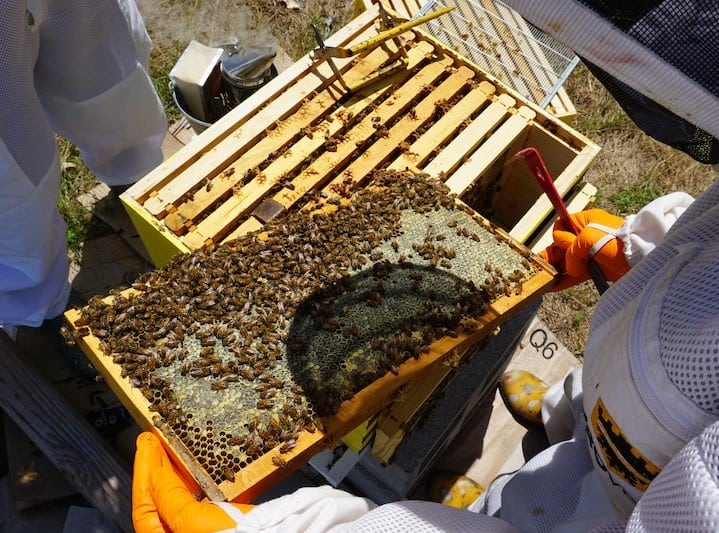
They Discourage New Occupants From Settling In
If the infestation goes unchecked and you are fortunate enough to attract a new swarm, the ladies may up and leave when they encounter all the fluff left behind by larvae. When the environment is not fit to live in, honey bees would seek to transfer to neighboring honey bee colonies in search of greener pastures.
Similarly, if an already occupied hive gets infested and the colony is weak, then the weak colony could be forced to leave as the larvae continue to spread out in the hive.
Save your Beehive from Wax Moth Infestation
The wax moth is a lightweight adversary. Sure, they can cause some costly damage, but the preventive measures are easy to implement.
The best measure is keeping your colony strong and maintaining a healthy hive. Then pest management becomes your bees’ problem, and they know how to handle it.
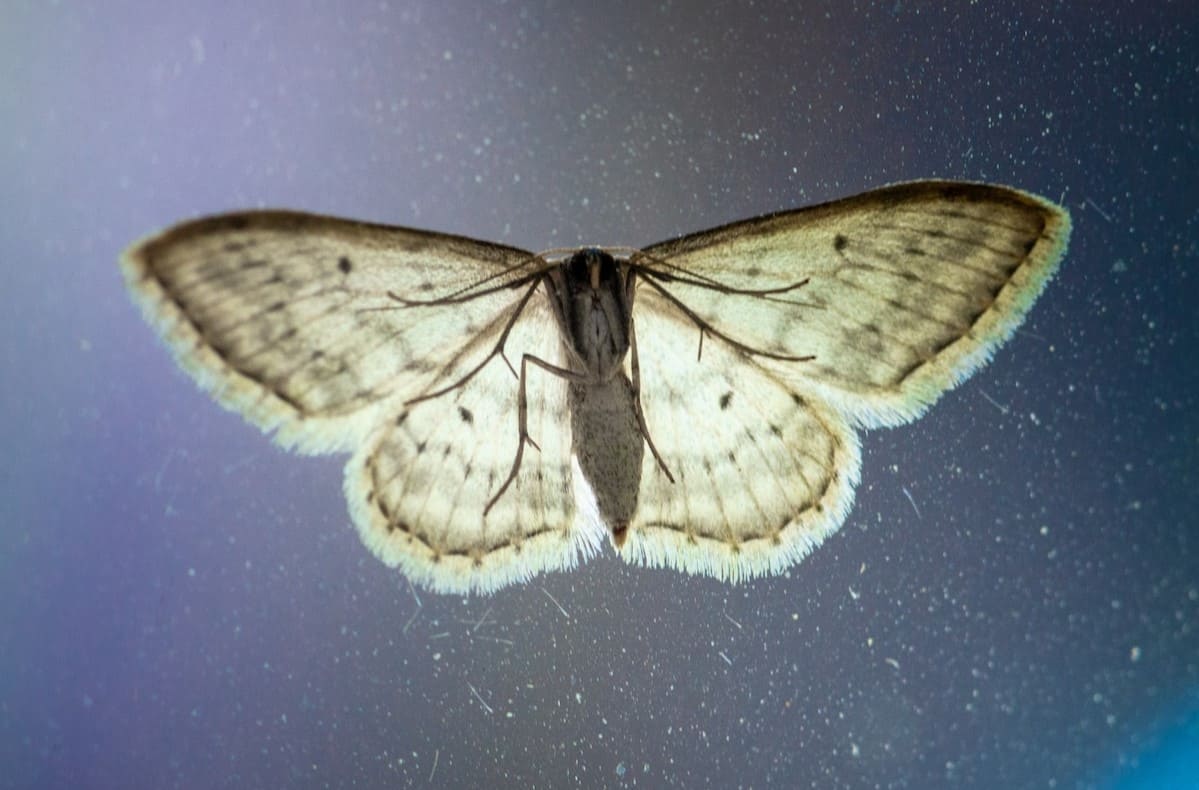
I was inspecting my colony today and discovered wax moths (worms) on the bottom board. I scrapped them off but wasn’t able to look at the frames do to it getting late in the evening. My colony is new but had filled all the frames in the brood box so 3 weeks ago I added a top box. Could this be my issue? Did I add on too soon? What steps do I need to take now that I know theses pests are there?